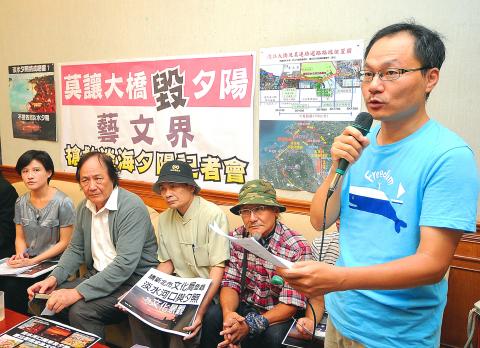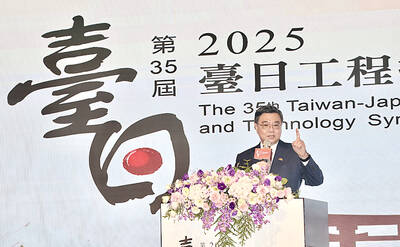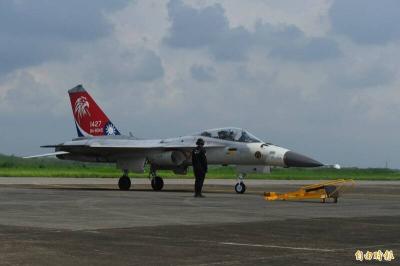Artists and writers yesterday called for the protection of the famous sunset at Tamsui River’s (淡水河) mouth as a piece of cultural heritage, while they protested against a planned bridge construction project.
However, the city’s department of cultural affairs said the sunset does not match designated criteria for cultural heritage.
The planned Tamkang Bridge (淡江大橋), which will connect Tamhai New Town (淡海新市鎮) in Tamsui and the Taipei Harbor (台北港) in Bali (八里), both in New Taipei City (新北市), received approval from an Environmental Impact Assessment meeting in June.

Photo: Fang Pin-chao, Taipei Times
Holding replica works of the sunset by famous painters, the representatives, accompanied by Democratic Progressive Party legislators Tien Chiu-chin (田秋堇) and Cheng Li-chiun (鄭麗君), spoke out in a bid to preserve the scenery at the river mouth, which has been voted more than once as one of Taiwan’s top-eight scenic spots.
“The key point is where to construct the bridge and how to balance economic development and cultural preservation... Many countries would not build a bridge that blights their most beautiful scenic view,” orchestra conductor Tseng Dau-hsiong (曾道雄) said.
Cheng said it was sad that the famous painting of the Tamsui sunset by renowned painter Chen Cheng-po (陳澄波) was sold for about NT$210 million (US$7 million) to Hong Kong, and now the government was unwilling to keep the real thing for future generations of Taiwanese to enjoy with their own eyes.
Sophie Seeing (施云), a documentary filmmaker, said the petition to the city’s Department of Cultural Affairs to designate the Tamsui sunset as cultural heritage was refused under the Enforcement Rules of the Cultural Heritage Preservation Act (文化資產保存法施行細則), which says cultural heritage requires the interaction between humans and nature, whereas the sunset is pure natural scenery that cannot be managed.
Liu Hsin-jung (劉欣蓉), assistant professor at Tamkang University’s Department of Architecture, said in order for the residents in Japan’s Kyoto to see giant bonfires lit on mountains surrounding the city during the annual Daimonji festival, the Japanese government had even set regulations on the height of buildings in the city, which he says means the preservation of culture must also consider symbolic meanings and people’s feelings for history and tradition as a whole.
Tseng Chi-tien (曾繼田), chief of the Cultural Heritage Division at the city’s Department of Cultural Affairs, said the sunset should not be tied together with the river mouth, because it can be seen in other places too.
If the bureau designates the Tamsui sunset as cultural heritage, it still lacks a property owner, manager and users, so it will be impossible to establish management plans, he added.
However, the Ministry of Culture’s Bureau of Cultural Heritage Deputy Director Nien Chen-yu (粘振裕) said the ministry cannot interfere with the city government’s authority on individual cases.
He said the ministry discovered that local governments have different identification criteria for designating cultural heritage, so the ministry will further discuss and communicate with the local governments on this aspect, adding that the education on the significance of cultural heritage in Taiwan must be improved too, especially among government officials and teachers.
While Tien suggested that the government spends more money to build an underwater tunnel to solve the traffic problem, Seeing suggested that the government should at least hold community consultation in the Tamsui area to gather public opinion.

LOW RISK: Most nations do not extradite people accused of political crimes, and the UN says extradition can only happen if the act is a crime in both countries, an official said China yesterday issued wanted notices for two Taiwanese influencers, accusing them of committing “separatist acts” by criticizing Beijing, amid broadening concerns over China’s state-directed transnational repression. The Quanzhou Public Security Bureau in a notice posted online said police are offering a reward of up to 25,000 yuan (US$3,523) for information that could contribute to the investigation or apprehension of pro-Taiwanese independence YouTuber Wen Tzu-yu (溫子渝),who is known as Pa Chiung (八炯) online, and rapper Chen Po-yuan (陳柏源). Wen and Chen are suspected of spreading content that supported secession from China, slandered Chinese policies that benefit Taiwanese and discrimination against Chinese spouses of

PROMOTION: Travelers who want a free stopover must book their flights with designated travel agents, such as Lion Travel, Holiday Tours, Cola Tour and Life Tours Air Canada yesterday said it is offering Taiwanese travelers who are headed to North America free stopovers if they transit though airports in Japan and South Korea. The promotion was launched in response to a potential rise in demand for flights to North America in June and July next year, when the US, Canada and Mexico are scheduled to jointly host the FIFA World Cup, Air Canada said. Air Canada offers services to 13 of the 16 host cities of the tournament’s soccer games, including Toronto and Vancouver; Mexico City, Guadalajara and Monterrey in Mexico; Atlanta, Georgia; Boston; Dallas; Houston;

ALIGNED THINKING: Taiwan and Japan have a mutual interest in trade, culture and engineering, and can work together for stability, Cho Jung-tai said Taiwan and Japan are two like-minded countries willing to work together to form a “safety barrier” in the Indo-Pacific region, Premier Cho Jung-tai (卓榮泰) yesterday said at the opening ceremony of the 35th Taiwan-Japan Modern Engineering and Technology Symposium in Taipei. Taiwan and Japan are close geographically and closer emotionally, he added. Citing the overflowing of a barrier lake in the Mataian River (馬太鞍溪) in September, Cho said the submersible water level sensors given by Japan during the disaster helped Taiwan monitor the lake’s water levels more accurately. Japan also provided a lot of vaccines early in the outbreak of the COVID-19 pandemic,

The US approved the possible sale to Taiwan of fighter jet spare and repair parts for US$330 million, the Pentagon said late yesterday, marking the first such potential transaction since US President Donald Trump took office in January. "The proposed sale will improve the recipient's capability to meet current and future threats by maintaining the operational readiness of the recipient's fleet of F-16, C-130," and other aircraft, the Pentagon said in a statement. Trump previously said that Chinese President Xi Jinping (習近平) has told him he would not invade Taiwan while the Republican leader is in office. The announcement of the possible arms